Ava Langford from Missouri, has filed a lawsuit claiming that she developed serious and severe personal injuries when a Bard G2 inferior vena cava (IVC) filter fractured and broke apart.
Langford filed her complaint in the U.S. District Court for the Eastern District of Missouri, alleging that a Bard G2 IVC filter failed and fractured. Langford received the medical device to prevent pulmonary embolism.
 Every year, thousands of patients are implanted with a retrieval inferior vena cava filters but they are not warned by doctors about the risk of injury from these temporary devices.
Every year, thousands of patients are implanted with a retrieval inferior vena cava filters but they are not warned by doctors about the risk of injury from these temporary devices.
And as time passes, patients tend to forget that they had this device implanted and the first inkling that they had the device, is when they suffer serious injury from a complication.
Experts say that there is a very high failure rate with these devices, which only increases with the duration of the filter in the body, and eventually all of the devices will fail. So 100% failure of the device becomes not a question of “if” but “when.”
According to Langford, the G2 filter is defectively designed, but Bard claims that the IVC filter device had “enhanced fracture resistance” and “increased migration resistance.” Langford claims that Bard failed to perform adequate clinical testing to ensure the filter device was safe and effective.
The filter devices are used when there is a blood clot in the leg known as a deep vein thrombosis and there is a contraindication to using blood thinners, which is the standard therapy for leg blood clots.
These devices are supposed to trap blood clots from traveling from the leg to the lungs and causing a pulmonary embolism, which can be fatal.
These devices unfortunately, have been linked to hundreds of adverse event reports where they puncture the vena cava, tilt out of position or migrate or break apart and cause metallic fragments to travel to the heart or lungs, a condition known as embolization.
2 Major Manufacturers of IVC Filters
There are 2 major manufacturers of IVC filters, Cook Medical and C.R. Bard. The complaints in the Bard and Cook IVC Filter litigation have similar allegations, the injured patients claim that the manufacturers designed and sold retrievable defective devices that were unreasonably dangerous.
FDA Warnings
The FDA in August 2010, announced a warning about the risk of IVC filter injuries, noting that they had received hundreds of adverse event reports where filter devices broke apart and travelled to other areas of the body or caused perforation and migration.
Bard IVC Filter Claims Consolidated in Arizona
All filed Bard Inferior Vena Cava filter injury, perforation and migration lawsuits, are consolidated and centralized in Phoenix, Arizona for coordinated pretrial proceedings.
Existing cases pending throughout the federal court system have been transferred to U.S. District Judge David G. Campbell, who will oversee the multidistrict litigation (MDL) proceedings. Bard Peripheral Vascular is the manufacturer of these Bard IVC filters and is headquartered in Phoenix, Arizona.
This consolidation and centralization of Bard IVC filter cases only applies to cases filed in the federal court system. According to latest court data there are 100 filed Bard Recovery filter and Bard G2 filter lawsuits currently pending in Arizona federal court. As the litigation matures it is expected that the final tally will consist of several thousand injury and defective product liability cases.
Benefits of MDL Consolidation and Centralization
The MDL streamlines the trial process, by preventing duplicative discovery and all the plaintiffs and defendants are gathered before one judge.
Cook IVC Filter Claims Consolidated in Indiana
MDL has been established for all Cook Medical IVC filter lawsuits, involving injuries with the Cook Celect and Gunther Tulip filters. There are more than 200 complaints over those products centralized before U.S. District Judge Richard L. Young in the Southern District of Indiana.
Lawsuits filed against Cook Medical over their defective IVC filters are gaining traction and moving towards trial. U.S. District Judge Young recently announced that a group of 10 Cook Medical IVC filter lawsuits have been chosen for early trial dates that will begin late 2016.
MDL Bellwether IVC Filter Trials
It is common in complex multidistrict ligation involving pharmaceutical and medical device cases, to have mini trials, known as bellwether trials.
A small group of cases will be prepared for early trial dates. The outcome of these trials are designed to aid settlement negotiations, especially if the jury sides with the injured plaintiffs and awards a large damage award or in cases involving gross negligence, awarding punitive damages, which are designed to punish the company for its reckless behavior.

 Dallas Fort Worth Injury Lawyer Blog
Dallas Fort Worth Injury Lawyer Blog



 Five products produced by C.R. Bard and Cook Medical are at the center of these lawsuits. These products include:
Five products produced by C.R. Bard and Cook Medical are at the center of these lawsuits. These products include: